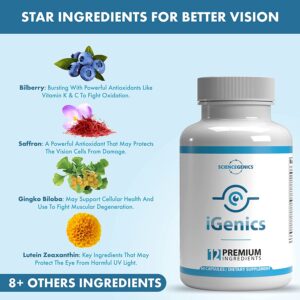Your eyes are among the most delicate organs in the body, constantly exposed to light, oxygen, and environmental stress. Over time, these exposures lead to the production of free radicals—unstable molecules that damage cells. This oxidative stress is a key factor in many eye conditions, including cataracts, glaucoma, diabetic retinopathy, and age-related macular degeneration (AMD).
The good news? Antioxidants for eye health play a vital role in neutralizing these free radicals, protecting delicate eye tissues, and preserving sharp vision. By adding antioxidant-rich foods and supplements to your lifestyle, you can significantly lower your risk of vision decline.
In this article, we’ll explore what antioxidants are, how they protect the eyes, the best types for vision, and how to include them in your diet.
What Are Antioxidants?
Antioxidants are compounds that protect cells from oxidative stress. They act like defenders, stabilizing free radicals before they can cause harm. Some antioxidants are produced naturally by the body, while others must come from food and supplements.
For the eyes, antioxidants are especially important because the retina and macula are highly sensitive to oxidative damage from UV light, blue light exposure, pollution, and aging. A lack of antioxidant protection speeds up the deterioration of eye structures and contributes to vision loss.
How Antioxidants Protect Eye Health
Here are some key ways antioxidants safeguard your vision:
- Neutralizing Free Radicals: Prevents oxidative damage to retinal cells.
- Reducing Inflammation: Helps soothe irritated eye tissues and reduces risk of chronic conditions.
- Protecting Macular Health: Guards the central vision area from degeneration.
- Supporting Tear Production: Reduces symptoms of dry eye syndrome.
- Slowing Age-Related Decline: Helps prevent cataracts and AMD.
Now, let’s look at the best antioxidants for eye health and how they improve vision.
The Best Antioxidants for Eye Health
1. Lutein and Zeaxanthin – The Eye’s Natural Filters
These carotenoids are found in high concentrations in the macula and act as a natural sunscreen for your eyes. They filter out harmful blue light from digital screens and sunlight.
Benefits:
- Protect against age-related macular degeneration
- Improve contrast sensitivity and visual sharpness
- Reduce risk of cataracts
Sources: Kale, spinach, broccoli, corn, egg yolks, zucchini.
2. Vitamin C – The Collagen Protector
Vitamin C is a water-soluble antioxidant that plays a critical role in maintaining healthy blood vessels in the eyes.
Benefits:
- Prevents oxidative stress in the lens
- Reduces risk of cataracts
- Strengthens connective tissues in the cornea
Sources: Oranges, strawberries, kiwi, bell peppers, Brussels sprouts.
3. Vitamin E – The Fat-Soluble Shield
Vitamin E is a powerful fat-soluble antioxidant that protects cell membranes from free radical damage.
Benefits:
- Slows progression of AMD
- Prevents oxidative damage to retinal cells
- Reduces risk of cataracts
Sources: Almonds, sunflower seeds, hazelnuts, avocado, spinach.
4. Zinc – The Vision Guardian
While technically a mineral, zinc works as an antioxidant by supporting enzymes that fight oxidative stress.
Benefits:
- Supports the transport of Vitamin A to the retina
- Protects night vision
- Reduces risk of macular degeneration
Sources: Lentils, chickpeas, pumpkin seeds, beef, oysters.
5. Beta-Carotene – The Night Vision Vitamin
Beta-carotene is converted into Vitamin A in the body, essential for producing rhodopsin, a pigment that helps you see in low-light conditions.
Benefits:
- Prevents night blindness
- Protects corneal health
- Reduces risk of dry eye syndrome
Sources: Carrots, sweet potatoes, butternut squash, apricots.
6. Omega-3 Fatty Acids – Anti-Inflammatory Protectors
Omega-3s are not classic antioxidants, but their anti-inflammatory properties make them vital for eye health.
Benefits:
- Prevents dry eye syndrome
- Supports retinal health
- Reduces risk of diabetic retinopathy
Sources: Salmon, sardines, chia seeds, flaxseeds, walnuts.
7. Anthocyanins – The Circulation Boosters
These antioxidants give berries their dark blue and purple color. They improve circulation in tiny capillaries that nourish the eyes.
Benefits:
- Improves night vision
- Reduces eye fatigue
- Protects retina from oxidative damage
Sources: Blueberries, blackberries, cherries, bilberries, grapes.
8. Curcumin – The Anti-Inflammatory Spice
Curcumin, the active compound in turmeric, is a powerful antioxidant with anti-inflammatory benefits.
Benefits:
- Protects against oxidative stress in retinal cells
- Reduces inflammation in the eyes
- May help manage diabetic retinopathy
Sources: Turmeric spice, golden milk, turmeric supplements.
Antioxidant Supplements for Eye Health
While a balanced diet should always come first, many people do not get enough antioxidants through food alone. Eye health supplements like those following the AREDS2 formula (Age-Related Eye Disease Study) combine lutein, zeaxanthin, zinc, Vitamin C, and Vitamin E to reduce the risk of AMD and support long-term vision.
Before starting supplements, consult with an eye doctor or healthcare professional, especially if you have existing health conditions.
Lifestyle Tips to Maximize Antioxidant Protection
- Eat the Rainbow: Include a wide variety of colorful fruits and vegetables.
- Stay Hydrated: Water supports nutrient absorption and eye lubrication.
- Limit Smoking and Alcohol: Both increase oxidative stress.
- Wear Sunglasses: Protect your eyes from UV damage that accelerates oxidation.
- Take Screen Breaks: Follow the 20-20-20 rule to reduce blue light exposure.
Final Thoughts
Antioxidants are essential allies in the fight against vision loss and age-related eye conditions. From lutein and zeaxanthin to Vitamin C, Vitamin E, zinc, anthocyanins, and omega-3 fatty acids, these nutrients work together to neutralize free radicals, reduce inflammation, and keep your eyes functioning at their best.
By combining a diet rich in antioxidant foods with healthy lifestyle habits, you can protect your vision, improve eye comfort, and enjoy clearer eyesight well into the future.
>>>Click here to restore your vision with the 12-second biblical trick.


